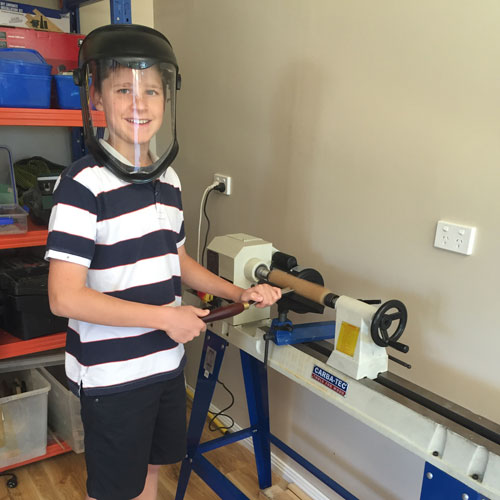Jordan Phillis came into our Brisbane Carbatec Store a few weeks ago, to buy his first lathe at the ripe old age of 12! Our staff were all really impressed by his enthusiasm and we wanted to learn more about how he found a passion for woodturning…

What got you into woodwork/woodturning?
It all started when we moved house when I was 2 and Dad gave me a screw driver to help take a bed apart... I learnt that lots of things could be taken apart with a screw driver and remember 'helping' by replacing all the dining room table screws with plastic ones out of my toy box. Mum only discovered this a year or so later when we went to move house again!
When I was 5, Mum and Dad gave me my first electric drill, saw and tool kit. This meant I could start making model boats and doing real damage! The boats floated — though you could never tell which side they'd choose as up!
I then moved onto a Dremel Scroll Saw when I was 9 and started cutting out shapes to turn into magnets, pen holders, and craft projects for my brothers and sister.
Mum and Dad both enjoy making things out of wood, so I also learnt how to make all kinds of play props, fences, decks/ramps/stairs. I made a frame in our shed so we could insulate and gyprock the walls, to make it more comfortable to work in.
The most interesting project I think I worked on was a magic disappearing box — we got the idea of YouTube. Mum designed it and after several weeks of work, we managed to perform the trick at our Annual Concert Night, which left everyone wondering!
My brothers and I went through a bit of a 'model plane stage', specialising in vintage planes. We used bits of aluminium cans for the propellers, bits of Mum's wire coat hangers for the props and leg struts and also found buttons in Mum's sewing room for the wheels.
My interest in lathes started when we went to the show one day and saw people making pens. I thought I'd like to have a try making pens and using them as gifts for friends and family — also to see if I could make same money out of them. I started saving birthday money, odd job money and pocket money to get enough for a lathe of my own. Progress was slow, so I wrote up a 'persuasive text' to my neighbour and managed to get the contract on mowing their lawn (they pay more than Mum and Dad). I also learnt how to sell things on Gumtree and after two years of saving, managed to buy my lathe and chisels.

What are you working on now?
I've only had my lathe a fortnight, so at this stage, I'm learning how to do various curves on a straight piece of wood and am having fun burning patterns using a piece of wire. I'm really looking forward to getting my chuck, so I can start making bowls. I'm starting to see the possibilities of my lathe and look forward to trying table legs, candlesticks, toilet roll holders and a holder for Mum's kitchen towel. I also have a friend looking for a special stand to display her orchids on, so that's something else I can have a go at when I get a bit better!
Where would you like to take woodworking in the future?
I'd really like to get an apprenticeship working with wood! I'd like to get into building houses — either in framing up the house in the first place, or in building kitchens, laundries and inside work areas. I'm also pretty keen to learn about doing rennos, restorations and extensions....It would be good to know what to do, so I can have fun with my own house one day! |